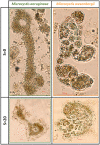Production and composition of extracellular polymeric substances by a unicellular strain and natural colonies of Microcystis: Impact of salinity and nutrient stress
- PMID: 37697704
- PMCID: PMC10667651
- DOI: 10.1111/1758-2229.13200
Production and composition of extracellular polymeric substances by a unicellular strain and natural colonies of Microcystis: Impact of salinity and nutrient stress
Abstract
The transfer of toxic cyanobacterial Microcystis blooms from freshwater to estuaries constitutes a serious environmental problem worldwide that is expected to expand in scale and intensity with anthropogenic and climate change. The formation and maintenance of Microcystis in colonial form is conditioned to the presence of extracellular polymeric substances (EPS). In this study, we attempted to better understand how the mucilaginous colonial form of Microcystis evolves under environmental stress conditions. In particular, we studied and compared the production and the composition of EPS fractions (attached and free) from natural colonies of a Microcystis bloom and from a unicellular M. aeruginosa strain under salinity and nutrient stress (representing a land-sea continuum). Our results highlighted a greater production of EPS from the natural colonies of Microcystis than the unicellular one under nutrient and combined stress conditions dominated by the attached form. In comparison to the unicellular Microcystis, EPS produced by the colonial form were characterized by high molecular weight polysaccharides which were enriched in uronic acids and hexosamines, notably for the free fraction in response to increased salinities. This complex extracellular matrix gives the cells the ability to aggregate and allows the colonial cyanobacterial population to cope with osmotic shock.
© 2023 The Authors. Environmental Microbiology Reports published by Applied Microbiology International and John Wiley & Sons Ltd.
Conflict of interest statement
The authors declare no conflict of interest.
Figures




Similar articles
-
Morphological and physiological impacts of salinity on colonial strains of the cyanobacteria Microcystis aeruginosa.Microbiologyopen. 2023 Jun;12(3):e1367. doi: 10.1002/mbo3.1367. Microbiologyopen. 2023. PMID: 37379426 Free PMC article.
-
Spatio-temporal connectivity of a toxic cyanobacterial community and its associated microbiome along a freshwater-marine continuum.Harmful Algae. 2024 Apr;134:102627. doi: 10.1016/j.hal.2024.102627. Epub 2024 Apr 18. Harmful Algae. 2024. PMID: 38705620
-
Insights into the relationship between colony formation and extracellular polymeric substances (EPS) composition of the cyanobacterium Microcystis spp.Harmful Algae. 2019 Mar;83:34-41. doi: 10.1016/j.hal.2019.02.006. Epub 2019 Feb 16. Harmful Algae. 2019. PMID: 31097254
-
Microcystis colony formation: Extracellular polymeric substance, associated microorganisms, and its application.Bioresour Technol. 2022 Sep;360:127610. doi: 10.1016/j.biortech.2022.127610. Epub 2022 Jul 15. Bioresour Technol. 2022. PMID: 35840029 Review.
-
Colony formation in the cyanobacterium Microcystis.Biol Rev Camb Philos Soc. 2018 Aug;93(3):1399-1420. doi: 10.1111/brv.12401. Epub 2018 Feb 22. Biol Rev Camb Philos Soc. 2018. PMID: 29473286
Cited by
-
Effects of salinity and nutrient stress on a toxic freshwater cyanobacterial community and its associated microbiome: An experimental study.Environ Microbiol Rep. 2024 Oct;16(5):e70029. doi: 10.1111/1758-2229.70029. Environ Microbiol Rep. 2024. PMID: 39444304 Free PMC article.
-
Towards the control of biofilm formation in Anabaena (Nostoc) sp. PCC7120: novel insights into the genes involved and their regulation.New Phytol. 2025 Aug;247(4):1805-1825. doi: 10.1111/nph.70317. Epub 2025 Jun 20. New Phytol. 2025. PMID: 40542494 Free PMC article.
-
Morphological and physiological impacts of salinity on colonial strains of the cyanobacteria Microcystis aeruginosa.Microbiologyopen. 2023 Jun;12(3):e1367. doi: 10.1002/mbo3.1367. Microbiologyopen. 2023. PMID: 37379426 Free PMC article.
References
-
- Abbasi, A. & Amiri, S. (2008) Emulsifying behavior of an exopolysaccharide produced by Enterobacter cloacae . African Journal of Biotechnology, 7(10), 1574–1576.
-
- Aminot, A. & Chaussepied, M. (1983) Manuel des analyses chimiques en milieu marin . Editions Jouve, CNEXO, 395 p.
-
- Bligh, E.G. & Dyer, W.J. (1959) A rapid method of total lipid extraction and purification. Canadian Journal of Biochemistry and Physiology, 37(8), 911–917. - PubMed
MeSH terms
Substances
Grants and funding
LinkOut - more resources
Full Text Sources

